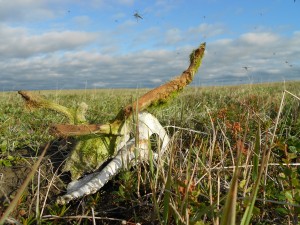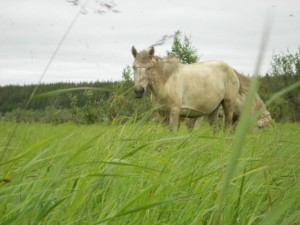
I have a fascination with the interaction of animals and plants. Although the relationship may appear to be as simple as an herbivore eating a plant then digesting it, there are more complex mechanisms at play. Plants use a lot of energy to create leaves, which in turn provides food for the plant through photosynthesis, and new growth to cover more of the area around it. When an animal eats those leaves or new growth the plant has to spend more energy to replace what was lost. Over time plants that experience browse will not be able to keep up with the energy required to grow foliage, and in turn another plant will take its place.
My project has three objectives that will help us understand these plant and animal interactions. The first portion identifies which plant community structures different herbivores use. Landscapes are diverse, and a variety of factors, such as elevation or the angle the slope of a hill faces the sun, can influence the growth of different plants. Driving down the road in Chersky it is not uncommon to see a patch of willow immediately followed by a patch of larch, and then come across a patch with a variety of other small shrubs. Each stand is suited for slightly different animals that take advantage of the specific resources available in that individual stand. In order to fully understand how an herbivore could influence the landscape we need to know which vegetation types they can be found in. We are determining this in two ways. First we evaluate the level of browse an area has experienced. This allows us to quantify how much influence an herbivore has on the plant community. Then we look for signs that animals have left behind, and that most commonly means scat (which is just scientific jargon for animal poop). Scat comes in a variety of sizes and shapes. Through these patterns we can identify which animal was at that location with relative ease.
The next objective investigates the effect of Moose browse on a plant community dominated by willow. These shrubs are highly favored by a wide variety of animals. However, moose can eat more willow in a day and have the potential to cause more of an impact in an area than smaller animals. We went through our habitat and selected areas that we implemented a various amount of browse. We will come back next year and quantify the changes to each location we see. With a reduction in competition for resources from willows other shrubs, such as dwarf birch and blueberry, should increase in size. Over time, selected patched that experience high willow browse should begin seeing a transition from a willow dominated stand to something different.
The last objective is a representation of the scientific method at its best. Science is the process of making observations, asking questions, and taking measurements to answer those questions. While out on the Tundra we noticed small areas that had been cleared of lichen due to reindeer browsing on the area. We noticed a similar disturbance in an area close to the station, where patches of moss where being kicked around creating a space that appeared inactive. We began wondering how these disturbances could influence the landscape around them. This portion of the project shows a lot of promise in explaining the interaction between animals, lichens and mosses. The bulk of our data collection will take place next year, which only excites me more for the 2014 field season.
These objectives only scratch at the surface of the complexity of plant animal interactions in Siberia. The biggest issue we face right now is keeping focused on the simple questions. The possibility for scientific discovery is endless. It’s like being a kid given free rein in a candy store; it can be difficult to find a starting point. We are constantly reminding ourselves not to make things so complicated we can’t explain our results. However this is why I love science, any new project brings with it excitement and wonder.




